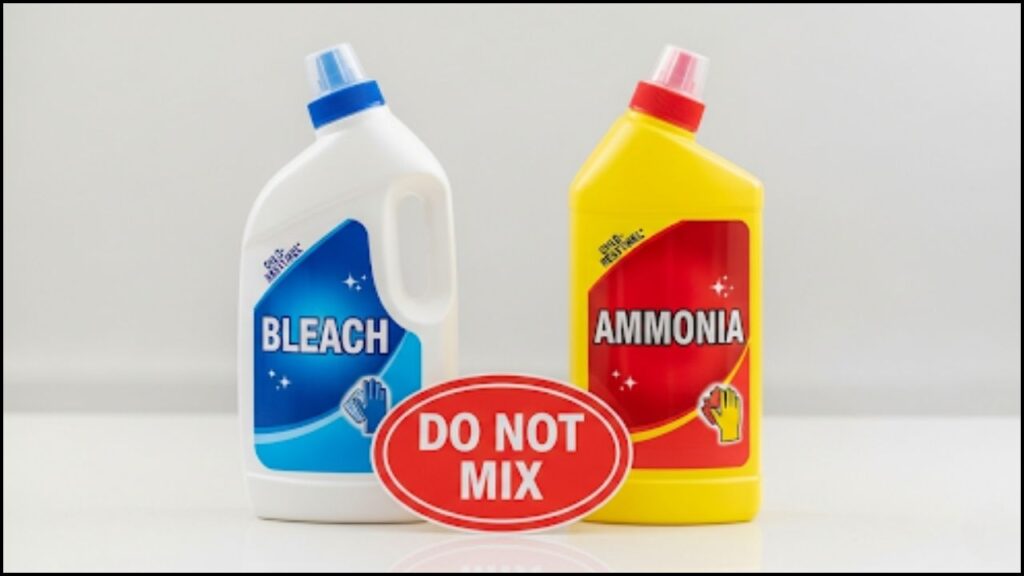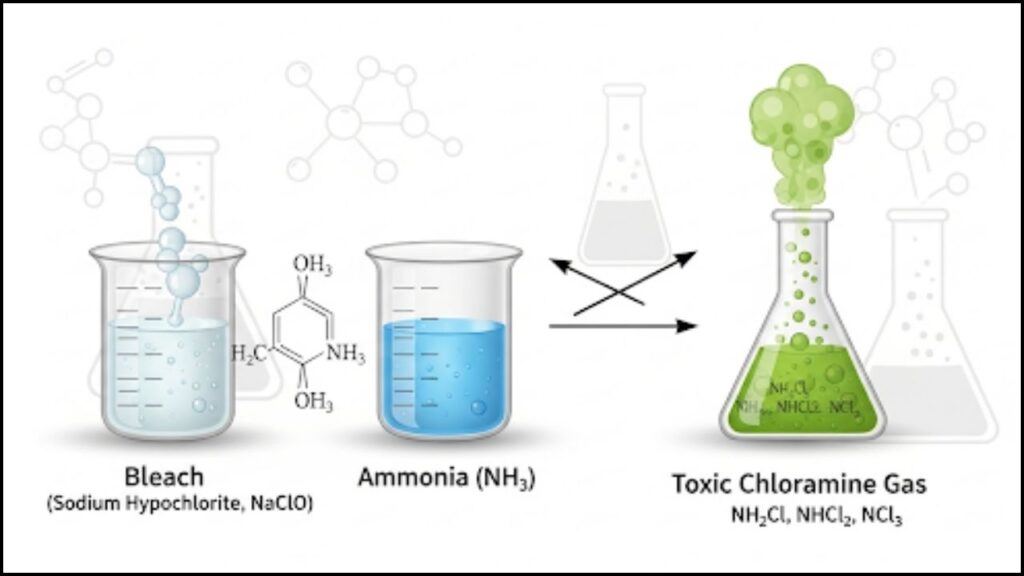A routine chore can quickly turn into a deadly situation. While many household cleaning products are safe on their own, combining certain common chemicals can produce toxic gases with fatal consequences. A primary example is the dangerous reaction created when combining bleach and ammonia, a mixture that professional cleaners are trained to avoid at all costs. The resulting fumes can cause severe respiratory distress, permanent lung damage, and even death, underscoring a critical safety message for households globally.

The Science of a Silent Danger
Chlorine bleach, a solution of sodium hypochlorite (NaOCl), is a powerful disinfectant used to kill germs and whiten fabrics. Ammonia, an alkaline compound of nitrogen and hydrogen (NH3), is a key ingredient in many glass and surface cleaners. When these two chemicals are mixed, they undergo a rapid and hazardous chemical reaction.
According to the U.S. Centers for Disease Control and Prevention (CDC), the combination of bleach and ammonia first creates a group of toxic compounds known as chloramines. These volatile chemicals can cause immediate and severe irritation to the eyes, nose, throat, and lungs. In higher concentrations, or in poorly ventilated areas, the effects can escalate dramatically. The reaction can further lead to the production of hydrazine, an extremely volatile and corrosive compound used as rocket fuel, which can cause convulsions, liver damage, and kidney failure.
“The immediate health risks are severe respiratory irritation and potentially life-threatening lung injury,” stated Dr. Sarah Miller, a chemical safety expert and professor at the University of California, Berkeley. “This isn’t a minor health risk; it’s a critical safety issue that most people are not aware of.”
The fumes can also be particularly dangerous for individuals with pre-existing conditions like asthma or chronic obstructive pulmonary disease (COPD), as they may suffer severe, irreversible damage from a single, brief exposure.

A Standard for Professional Cleaners
For professional cleaning services and janitorial staff, the danger of mixing these chemicals is a foundational part of their training. Industry standards, often guided by the Occupational Safety and Health Administration (OSHA), mandate strict protocols to prevent such incidents.
“Our training begins with a comprehensive understanding of chemical compatibility,” said Mark Johnson, a veteran professional cleaner and safety coordinator for a major cleaning company in London. “You never mix products unless the manufacturer’s instructions explicitly permit it. The golden rule is always to use one product at a time and rinse surfaces thoroughly before applying another.”
This strict separation extends to the storage and use of cleaning agents. Cleaners are instructed to keep bleach-based products in a separate area from ammonia-based products to prevent accidental spills or cross-contamination. This practice, known as chemical segregation, is a cornerstone of workplace safety.
The Dangerous Chemistry of Mixing Bleach and Ammonia
| Key Fact | Detail/Statistic |
| Primary Hazard | The combination of bleach and ammonia produces highly toxic chloramine gas. |
| Health Risks | Inhalation can cause severe respiratory damage, lung burns, and is potentially fatal. |
| Common Products | Bleach is found in disinfectants and whiteners; ammonia is common in glass cleaners and degreasers. |
Real-World Consequences and Public Health Advisories
Despite widespread warnings, accidental poisonings and injuries still occur. The National Capital Poison Center reports thousands of incidents each year involving cleaning products, with a significant number directly related to improper mixing. Many of these cases happen in residential settings, where a lack of professional training and a desire for a “stronger” cleaning solution led to dangerous experimentation.
“The most common mistake we see is people thinking that combining products will make them more effective,” said Dr. Miller. “It’s a misconception that more is better. In reality, you’re creating a new, toxic substance.” The U.S. Environmental Protection Agency (EPA) and other health bodies worldwide consistently issue public service announcements and safety guidelines on this topic. They advise consumers to always read product labels, which typically carry warnings against mixing with other chemicals. The advice is simple: if the label says not to mix, do not mix.
A Broader Lesson in Chemical Safety
The specific danger of mixing bleach and ammonia is a powerful lesson in a broader principle of household safety. Many other common cleaning chemicals can also react dangerously. For instance, combining bleach with acids—such as vinegar or toilet bowl cleaners—produces highly toxic chlorine gas, which was famously used as a chemical weapon in World War I. Similarly, mixing different drain cleaners can cause violent, explosive reactions.
The takeaway is that different chemical families should be respected and kept separate,” said John Henderson, a retired chemist and chemical safety consultant. “You can’t assume that because two products are sold in a grocery store, they are safe to combine.” Consumers should adopt the same disciplined approach as professionals: never mix products, use them in well-ventilated areas, and store them securely away from children and pets. This simple regimen can prevent a significant number of household accidents and create a safer environment for everyone.
Post-Vacation Cleaning: Four Immediate Tasks to Simplify Your Return Home
